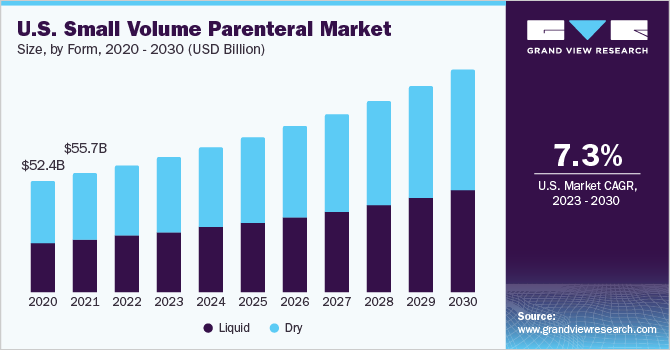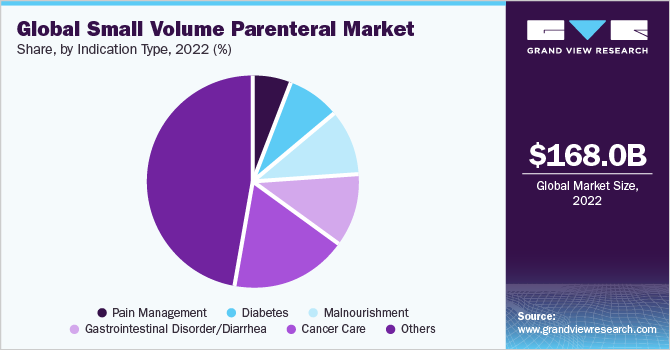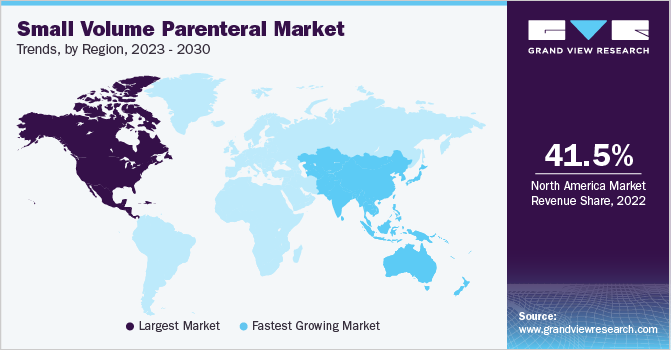- Home
- »
- Pharmaceuticals
- »
-
Small Volume Parenteral Market Size & Share Report, 2030GVR Report cover
![Small Volume Parenteral Market Size, Share & Trends Report]()
Small Volume Parenteral Market Size, Share & Trends Analysis Report By Packaging Type (Ampoules, Vials), By Dose Type (Single-dose, Multiple-dose), By Indication Type (Cancer Care, Diabetes), By Form, And Segment Forecasts, 2023 - 2030
- Report ID: GVR-4-68040-126-9
- Number of Report Pages: 180
- Format: PDF, Horizon Databook
- Historical Range: 2018 - 2021
- Forecast Period: 2023 - 2030
- Industry: Healthcare
Report Overview
The global small volume parenteral market size was estimated at USD 168.0 billion in 2022 and is projected to grow at a compound annual growth rate (CAGR) of 7.5% from 2023 to 2030. The demand for small-volume parenteral (SVPs) has steadily risen due to the increasing prevalence of chronic diseases and the necessity for various intravenous medications in healthcare facilities. The growing geriatric population, particularly in developed nations, results in a higher requirement for medical interventions. SVPs are commonly used for their ease of administration and accurate dosing, driving market demand. Moreover,advancements in pharmaceutical manufacturing processes and packaging technologies are improving the safety, quality, and shelf life of SVPs, making them more reliable for healthcare providers and patients.

Also, itallows for more precise and consistent production of SVPs, ensuring that each dose contains the intended amount of active pharmaceutical ingredients. This increased accuracy in dosing contributes to better treatment outcomes and patient safety, thereby positively impacting the market growth. Furthermore, the growth of biopharmaceuticals and personalized medicine drives the demand for SVP as it facilitates the safe and precise delivery of these specialized medications. In addition, the increasing elderly population is a significant factor driving the growth of the global market.
According to a report by the United Nations, the global population of individuals aged 60 years and above is projected to rise significantly, from 962 million in 2017 to 2.1 billion by 2050 and 3.1 billion by 2100. Due to the growing elderly population, there is a higher prevalence of chronic diseases and conditions that require consistent medical treatment, often involving injectable medications and fluids. Elderly individuals typically have a higher likelihood of hospitalization and may require specialized care that includes SVP products for various therapies. This demographic trend not only increases the overall demand for SVP products but also fosters innovation in the development of targeted therapies and delivery systems that cater to the unique healthcare needs of older adults.
Form Type Insights
In 2022, the dry form segment accounted for the largest share of 55.5%. Dry SVPs typically have a longer shelf life compared to liquid SVPs. Also, it offers flexibility in dosing, as healthcare providers can reconstitute the medication with a specific volume of liquid to achieve the desired concentration. In addition, the lyophilization process reduces the risk of microbial contamination, making dry SVPs advantageous for medications that are susceptible to degradation in liquid form.
The liquid SVP segment is anticipated to grow at the fastest CAGR from 2023 to 2030 as it offers convenience as they are ready to use and require no reconstitution before administration, making them suitable for quick and efficient drug delivery in emergency and critical care situations. Also, hospitals and healthcare facilities often rely on liquid SVPs for various treatments and procedures due to their ease of use and rapid administration. In addition, small SVPs are frequently administered intravenously, making them a preferred choice for medications requiring systemic effects or for patients who cannot take medications orally.
Dose Type Insights
The single-dose containers segment held the largest share of 60.0% in 2022. A single-dose container is a container of a parenteral preparation that is not required to meet the antimicrobial effectiveness testing requirements. A single-dose container is designed for use with a single patient as a single injection/infusion. Examples of single-dose containers are vials, ampules, and prefilled syringes. Reduced risk of contamination, preservation of sterility, accurate dosing, convenience & efficiency are some of the factors contributing to the segment growth.
The multiple-dose container segment is anticipated to witness the fastest CAGR from 2023 to 2030. A multiple-dose container is a container of a parenteral preparation that has met antimicrobial effectiveness testing requirements or is excluded from such testing requirements by FDA regulation. It is intended to contain more than one dose of the drug product. Multiple-dose containers are generally expected to contain 30 mL or less of product. The beyond-use date for an opened or entered (e.g., needle-punctured) multiple-dose container is 28 days unless otherwise specified by the manufacturer on the label. An example of a multiple-dose container is a vial.Multiple-dose vials are often more cost-effective than single-dose containers. Also, patients undergoing long-term treatment usually choose multiple-dose containers, thereby driving the segment growth.
Packaging Type Insights
The ampoules dominated the packaging type segment. It held the largest revenue share of 28.0% in 2022 and is expected to continue its dominance over the forecast period. Ampoules offer precise and sealed packaging, ensuring accurate dosage administration and minimizing contamination risks. Their single-use design enhances patient safety by preventing cross-contamination.
Ampoules also cater to the growing demand for convenient and ready-to-administer drug delivery solutions, especially in emergency and clinical settings. These factors, coupled with the global emphasis on sterile packaging and efficient drug delivery, are driving the segment growth.
Indication Type Insights
Based on indication type, the others segment dominated the market with a share of 47.5% in 2022.The other indication segment mainly involves Crohn’s disease, cystic fibrosis, pancreatitis, other cancer-related treatments, and other health ailments. Patients undergoing heavy therapies, such as radiation therapy, immunotherapy, and medication, have severe loss of nutrition due to metabolic changes, loss of appetite, and changes in the immune system. Weight loss is the major physical change observed among such patients. Therefore, SVP is suggested to such patients to balance their nutrition.Thus, the rising prevalence of various conditions wherein SVP can be used for the restoration of nutritional balance is impelling segment growth.

However, the dysphagia segment is anticipated to witness the fastest growth rate over the forecast period due to the high disease prevalence. According to an article published in MDPI in 2022, the prevalence of dysphagia among elderly nursing home residents was around 58.69%, which was evaluated by the Standard Swallowing Assessment (SSA). Also, the prevalence of dysphagia in combined community-dwelling elderly was around 30.52%. Aspiration pneumonia due to dysphagia is a major complication of this condition, which boosts the need for parenteral nutrition, thereby positively impacting the market growth.
Regional Insights
North America accounted for the largest revenue share of more than 41.5% in 2022. Key factors responsible for its highest market share include high research expenditure by private entities & government agencies in the healthcare sector; technologically advanced medical devices; and collaborations among the medical device industry, regulatory authorities, universities, and others. In addition, the growing prevalence of various chronic diseases, such as cancer and malnutrition, and the presence of advanced healthcare facilities, favorable reimbursement policies & regulations in the region have led to a high hospital admission rate, which supported the product demand.

Asia Pacific is anticipated to register the fastest CAGR of 8.4% during the forecast period. The growing prevalence of chronic diseases due to unhealthy eating habits and rising demand for cost-effective treatment care are some of the factors expected to drive the regional market growth. Moreover, the increasing population, coupled with poverty & low awareness about nutrition in the region, is leading to malnutrition, which is one of the key factors boosting the product demand.
Key Companies & Market Share Insights
Continuous investments by market players and approvals from the government for the development of advanced PN solutions have led them to gain a competitive edge in the market, thereby driving market growth. For instance, in July 2022Akums Drugs & Pharmaceuticals Ltd., a prominent pharmaceutical contract manufacturing company in India, obtained European Union Good Manufacturing Practice (EU GMP) certification for two manufacturing facilities situated in Haridwar.
These facilities are dedicated to producing both large-volume parenterals and small-volume parenterals, which encompass vials and ampoules. In addition, companies are actively involved in improving their current product portfolio to sustain their position in the market. New drug development by companies and their entry into untapped markets to expand their reach are also expected to boost industry growth. Some of the key players operating in the global small volume parenteral market are:
-
BML Parenteral Drugs
-
Rusoma
-
B. Braun Melsungen AG
-
FRESENIUS KABI AG
-
BAXTER
-
SICHUAN KELUN
Small Volume Parenteral MarketReport Scope
Report Attribute
Details
Market size value in 2023
USD 179.6 billion
Revenue forecast in 2030
USD 298.5 billion
Growth rate
CAGR of 7.5% from 2023 to 2030
Base year for estimation
2022
Historical data
2018 - 2021
Forecast period
2023 - 2030
Quantitative units
Revenue in USD billion and CAGR from 2023 to 2030
Report coverage
Revenue forecast, company ranking, competitive landscape, growth factors, and trends
Segments covered
Form, dose type, packaging type, indication type, region
Regional scope
North America; Europe; Asia Pacific; Latin America; MiddleEast & Africa
Country scope
U.S.; Canada; Germany; UK; France; Italy; Spain; Sweden; Norway; Denmark; Japan; India; China; Australia; Thailand; South Korea; Brazil; Mexico; Argentina, South Africa; Saudi Arabia; UAE; Kuwait
Key companies profiled
BML Parenteral Drugs; Rusoma; B. Braun Melsungen AG; FRESENIUS KABI AG; BAXTER; SICHUAN KELUN
Customization scope
Free report customization (equivalent up to 8 analysts working days) with purchase. Addition or alteration to country, regional & segment scope.
Pricing and purchase options
Avail of customized purchase options to meet your exact research needs. Explore purchase options
Global Small Volume Parenteral Market Report Segmentation
This report forecasts revenue growth at the global, regional, and country levels and provides an analysis of the latest trends in each of the sub-segments from 2016 to 2030. For this study, Grand View Research has segmented the global small volume parenteral market report on the basis of form, dose type, packagingtype, indication type, and region:
-
Form Outlook (Revenue, USD Billion, 2018 - 2030)
-
Liquid
-
Dry
-
-
Dose Type Outlook (Revenue, USD Billion, 2018 - 2030)
-
Single-dose
-
Multiple-dose
-
-
Packaging Type Outlook (Revenue, USD Billion, 2018 - 2030)
-
Ampoules
-
Vials
-
Pre-filled Syringes
-
Cartridges
-
Bottles
-
Others
-
-
Indication Type Outlook (Revenue, USD Billion, 2018 - 2030)
-
Pain Management
-
Cancer Care
-
Malnourishment
-
Gastrointestinal disorder/Diarrhea
-
Diabetes
-
Others
-
-
Regional Outlook (Revenue, USD Billion, 2018 - 2030)
-
North America
-
U.S.
-
Canada
-
-
Europe
-
Germany
-
UK
-
Italy
-
Spain
-
France
-
Sweden
-
Denmark
-
Norway
-
-
Asia Pacific
-
China
-
India
-
Japan
-
Thailand
-
South Korea
-
Australia
-
-
Latin America
-
Brazil
-
Mexico
-
Argentina
-
-
MEA
-
South Africa
-
Saudi Arabia
-
UAE
-
Kuwait
-
-
Share this report with your colleague or friend.
![gvr icn]()
NEED A CUSTOM REPORT?
We can customize every report - free of charge - including purchasing stand-alone sections or country-level reports, as well as offer affordable discounts for start-ups & universities. Contact us now
![Certified Icon]()
We are GDPR and CCPA compliant! Your transaction & personal information is safe and secure. For more details, please read our privacy policy.
We are committed towards customer satisfaction, and quality service.
"The quality of research they have done for us has been excellent."





